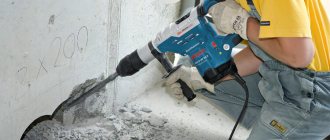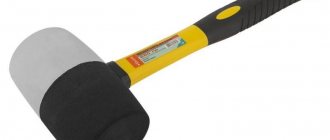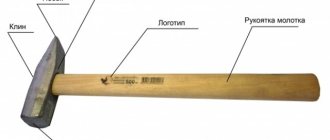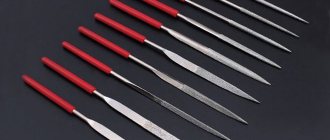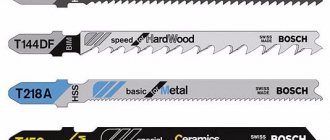Hammer design and basic materials
The first hammer appeared a long time ago. We can say that this is the first of the tools that people used for their needs. We have all seen a hammer, held it in our hands many times and know that the simplest hammer consists of two main elements : a handle and a head.
The head has an asymmetrical shape, one part of it has a pointed point, which is called a wedge, and the other part is flat or slightly convex, called the striker. This is the main striking part of the hammer , which does the main work. It has sufficient strength and area to withstand repeated impacts on hard surfaces. The wedge-shaped part of the hammer is used for splitting something or for coining.
Its shape allows the development of greater impact force due to the smaller contact surface area. In the center of the head there is a special hole for attaching the handle, which is called vsad . Usually it is made in the form of a round or oval hole, which smoothly turns into a cone. After attaching the head to the handle, the part of it that protrudes from the hole is wedged out so that it completely occupies the internal cavity of the insert. This fastening prevents the head from falling off .
In order to ensure high strength and durability of the head, it is made of high-strength metal by forging, casting or milling, followed by heat treatment. Special hardening modes make it possible to achieve high surface strength with a viscous core. The hardened surface layer reaches 3-5 mm. This structure provides high hardness, but at the same time protects the head from fragility.
To
protect the head from corrosion, it is galvanized or special types of paints are used.
a universal material for making handles . It is very durable, does not slip in your hand and has a long service life, and if you break the handle during use, it is very easy to replace it or even make it yourself. It is very important that the grain of the wood from which the handle is made is perpendicular to the head. In this case, if it breaks, you will not be injured. species must be of a certain type . Beech, birch, ash, oak, hornbeam, maple or rowan are well suited for these purposes. Unsuitable species are pine, aspen, alder and spruce.
There are handles made of metal or plastic , and more modern hammers come with fiberglass handles. This is a new material that has proven itself very well in use. It does not slip in the hand and helps reduce recoil upon impact. The metal handles are hollow inside, have the shape of a circle in cross section, and are covered with rubber for ease of use. The plastic handles are also covered with a layer of rubber. Handles made of plastic, metal or fiberglass have two advantages over wood: they do not dry out over time and are not susceptible to swelling when in contact with water. Choose depending on which material is more convenient and enjoyable for you to work with. The main thing is that the handle is much lighter than the head and has the appropriate length.
Types of hammers and what they are used for
There is a significant range of hammers that you can buy, but the average person will only keep 2 or 3 of them in their tool bag and that's probably all they'll ever need.
Here are the most common types of hammers that people use today:
nail puller
This hammer is the most common type of hammer and is probably what comes to mind when most people think of a hammer. The claw hammer is a versatile hammer and can be used for many jobs. This makes it an absolute must-have for any tool bag. The most common weights are from 455 to 680 g.
The claw is used as a lever; usually has a notch that is used to pull nails out of wood. The claw is inserted under the head of the nail so as to catch the head. The hammer is then lifted and, using the claw as a fulcrum, pulled onto the handle.
The claw can be used for leverage in other situations, such as ripping off boards, but overuse can put stress on the joint between the head and handle, so check this area regularly.
Cross and straight Payne, Warrington or carpenter's hammers
They are different hammers for different purposes, determined largely by the weight and strength of the head. They all have a similar head shape with a cross or straight nose (also spelled "Peen") on the opposite side of the hammer head.
Warrington, carpenter's and Cross Pein hammers are mainly used for working wood. The Paine cross is used for hammering small objects from a button to a stud.
If you are holding a small nail with your fingers, it can be difficult to hit the head of the nail without hitting your fingers. Cross Payne can, by lightly tapping a nail between his fingers, hammer it in without injuring his finger.
The Pein can be at right angles to the handle (straight Pein) or parallel to it (cross Pein), but most often you'll see the cross Pein as most useful for driving nails and small nails.
Heavier cross or straight pein hammers are primarily used for shaping metal.
Round Payne
These hammers are sometimes called engineering hammers or mechanic's hammers. They have a rounded shape at the edge and hence the name: bol (from English - “ball”) payne. They are used to shape metal, cover a rivet, and round the edge off metal pins and fasteners.
Straightening, the process of manufacturing metal structures, is little used these days, as is hardening the surface of the metal by repeated tapping.
This was mainly done with the flat side of a hammer.
The weight of ball-pain hammers varies from 55 - 1100g, although most of them are in the region of 110 - 165g. Handles are traditionally made from ash or hickory, although modern materials are now more commonly used as they dampen vibration upon impact.
Sledgehammer or cone hammer
It's used to hit a chisel, break up masonry, or just smash things like a tiny sledgehammer. They are usually double-sided and have a wooden or resin handle. They are a vital tool for the builder and are used throughout the construction project.
Blacksmith Hammer
They are similar to cone hammers, only they have a longer handle and are usually a little heavier (3-14 kg). They are used to destroy masonry, stones and concrete. They are also useful for driving stakes.
Real force can be applied by swinging the hammer like an axe; The large handle combined with the weight of the head will provide enormous momentum and striking power.
A variation is the Deadblow hammer (a sledgehammer with a rubber knob on the end). This is another hammer designed to minimize surface damage and is designed to provide maximum power upon impact.
As a rule, they have an internal cavity filled with steel or lead shot. This increases the impact force, which allows you to deliver a more powerful blow without the risk of damaging the object, and also reduces the rebound when a blow is made, since the hammer head remains on the surface after impact.
Kiyanka
A mallet is a wooden block with a handle. It is used to drive a chisel, drive dowels, or join wood joints together. It is an essential tool for a carpenter or carpenter.
They are typically made from beech (hardwood) and are used where a metal hammer would cause damage to the surface or where other tools such as a chisel are used.
In general, the head of the hammer is made slightly conical to ensure proper contact with the workpiece you are working on.
We've covered the most commonly used type of hammer so far, but there are a number of less commonly used hammers that are used in specialized jobsites.
Drywall hammers
Drywall Hammer - A drywall hammer that has a small hatchet on one end of the head and a hammer on the other. The ax is used for cutting drywall for pipes and various holes or openings in plasterboard.
Sometimes they have magnetic heads to hold pins, screws/nails, which can be very useful. Traditionally, a plaster hammer used to be used (for nailing shingles), but now drywall is used and this hammer is not necessary, except for work in old buildings.
Rubber and soft hammers
Rubber and soft hammers are hammers that are designed to not damage the surface you are working on and are sold separately for wall, wood, chisel, etc.
These hammers can have interchangeable hammer shapes, which are useful for woodworking, loosening tight doors/windows, working on fittings including chrome and rubber surrounds, or for light assembly work: getting parts into place.
Aluminum hammersAluminum hammers are soft hammers that are used to shape metal without damaging the forming surface. | Falling HammerDrop Hammers - Used to shape metal on a block or anvil. |
Copper and covered hammerCopper and Covered Hammer - The head of the hammer is made of copper at one end and rawhide at the other. It is used to reshape metal when you don't want the hammer to leave marks on it, such as on the body of a car. | Geologist's JackhammerA geologist's jackhammer is a small, spiked ax for breaking rocks. At the other end, the head provides a flat surface for breaking small rocks. In addition to geologists looking for fossils, masons sometimes use these hammers to loosen joints in old brickwork. |
Rack hammersLath hammers are hammers with a small ax on one end for cutting and for nailing and nailing plaster strips. | Ironing hammerA smoothing hammer is a hammer for working on metal. It is used to smooth out metal that has previously been shaped with another hammer. |
Roofers' and tilers' hammersThis hammer is used by roofers. It has a tenon on one end to create nail holes in slate. With the other end they knock on the nails that hold the slate in the roof sheathing. It usually has a grip in the middle for pulling out (removing) nails. | Upholstery hammersUpholstery Hammers - These hammers usually have one magnetized or splined head to secure the upholstery nails, and then you can turn the hammer and use the other end of the normal head hammer to finally drive the nail in. Both sides on the head are small and tender. |
BushhammerA mason's hammer is used to chip (peel) old mortar off bricks and tiles. | Descaling hammerThese hammers are used to remove scale and scale from boilers and large pipes. |
Hammer-pick (mason)Pick Hammer (Mason) - This is a hammer used by builders sometimes as a chisel (Paine) at both ends, or sometimes they may have a hammer at one end and a chisel at the other. Typically, they are used to break bricks cleanly. | Pin or frame hammersPin or Frame Hammers - These hammers are used by photo frame makers. |
Pneumatic hammers
These powerful tools drive nails, tacks and staples and are called pneumatic hammers.
It can be electric or pneumatic and is powered by electricity or gas, respectively. It is designed to make heavy work easier, such as those involving many nails or fitting floor slabs. If you found this page interesting, share the link to it with your colleagues and friends by clicking on one of the buttons below. Surely someone will be grateful to you.
Plumber's hammer and its purpose
The design of a plumber's hammer is described in detail in the first paragraph. This is the simplest and most common type of working tool. It is designed for hammering, breaking, bending or straightening parts.
The pointed edge in the form of a wedge allows you to drive a nail with a small head and do work in hard-to-reach places where the wide part of the head does not fit. The head of a plumber's hammer can have not only a square, but also a round cross-section. The square type has one drawback - if at the moment of impact you skew the hammer and the inclined angle falls on the surface of the material being processed, a dent will certainly remain on it. Such defects are especially distressing when assembling new furniture.
Since a plumber's hammer is designed to apply multiple series of blows, it must be made of very durable material . Chrome vanadium steel is ideal because it has increased hardness, which will help avoid deformation or destruction of the striker. The weight of a plumber's hammer varies depending on its number. five numbers in total , weight No. 1 - 200 g, No. 5 - 800 g. The weight of the hammer is selected depending on the type of work and the physical strength of the worker. The length of the handle , on average, is 300-400 mm.
Rating of the best hammers
| Nomination | place | Name of product | price |
| The best locksmith hammers | 1 | Gross 10400 | 1 720 ₽ |
| 2 | Sata 92406 | 1 050 ₽ | |
| 3 | Center tool 0605-1000 | 827 ₽ | |
| 4 | Inforce 59035 | 345 ₽ | |
| 5 | FIT 44302 | 375 ₽ | |
| The best mason's hammers | 1 | Archimedes 90419 | 699 ₽ |
| 2 | FIT 44540 | 838 ₽ | |
| The best carpentry hammers | 1 | Stanley FMHT1-51276 | 3 253 ₽ |
| 2 | NEO 25-000 | 1 094 ₽ | |
| 3 | FIT 44789 | 729 ₽ | |
| 4 | Sparta 104105 | 265 ₽ | |
| The best straightening hammers | 1 | JONNESWAY M10110 | 1 610 ₽ |
| 2 | KING TONY 7842-28 | 970 ₽ | |
| The best roofer hammers | 1 | Stanley 1-51-037 | 1 130 ₽ |
| 2 | Archimedes 90437 | 549 ₽ |
Carpenter's hammer
The design of the carpenter's hammer has a distinctive feature . At one of its ends there is a special slot, which can have a different opening angle and slightly curved edges. This bifurcation serves to remove nails from the required surface. Hammers with a large groove angle are called California hammers, and those with a smaller angle are called European hammers. But not all carpenter's hammers are shaped like a nail gun at one end. There are tools with a regular wedge at the end and a perfectly straight striker.
The handle can be made of wood, metal or plastic with a rubber coating, which serves to prevent slipping in the hand. Such hammers are considered to be precision instruments rather than percussion instruments. The mass of its head lies in the range of 100-800 g in increments of 50 g.
A carpenter's hammer can look extremely simple - a striking part made of tool steel and a wooden handle, or have a more ergonomic shape and some additional functions. For example, its handle can be made of high-strength fiberglass or carbon fiber, and the striking part can be made of titanium or other high-strength steel with a special anti-corrosion coating and undergone special heat treatment. As an additional feature, a nail holder may be present, which allows you to perform work with one hand. And its design can be folding or collapsible, which makes it very compact and convenient for storage.
The best spinning hammer
SANTOOL 030833-675
This type of hammer is also called a recoilless hammer. People call this instrument a mallet. All such hammers are very similar to each other, their design has been verified over the years. Specifically, SANTOOL 030833-675 has a length of 320 mm. At the end of the handle present here there is a thickening that can serve as a stand. The firing pin has a 50 mm diameter, which is enough in the vast majority of cases.
Advantages:
- Optimal length;
- Reliable and proven design;
- Decent firing pin diameter;
- Weight is 680 grams.
Flaws:
- May seem expensive.
READ ALSO
8 best screwdrivers
4. Sledgehammer
This is the largest , most powerful and heaviest type of hammer. The weight of such a tool can reach 4-10 kg, but there are also more serious tools that have a working part weight of up to 16 kg. They are used for work that requires high impact force but little precision, for example, dismantling partitions, old tiles, crushing concrete or stone, driving poles into the ground, driving wedges and other heavy work.
The head of this tool is made of high-strength steel by forging followed by heat treatment in the form of hardening to the required hardness and can be in the shape of a parallelepiped or an ordinary hammer. By the way, the depth of the hardened layer after hardening reaches 30 mm. The handle has a larger diameter and length compared to previous models, which means two-handed operation.
The length of the handle is directly proportional to the weight of the working part of the sledgehammer: the higher it is, the longer the handle and can reach 120 cm, but is usually in the range of 80-90 cm. The cheapest sledgehammers have a wooden handle, but they can also be all-metal.
The hole into which the handle is inserted has a conical shape, and the handle itself is inserted from above and does not need to be wedged. This assembly method completely prevents the massive head part from slipping off. When working with a sledgehammer, you must be extremely careful, because it is considered a dangerous tool. There are several types of sledgehammers , but the most used are the blunt-nosed sledgehammer weighing 2-16 kg, longitudinal or pointed-nosed transverse, which weigh from 3 to 8 kg. The preferred handle option is a rubberized one; it is more expensive than a wooden one, but the tool will be securely held in your hands and dampen vibration during impacts.
Look at life more broadly, and hold the hammer handle tighter
Particularly high demands are placed on the hammer handle. It should be durable, light, well-cushioned, and comfortable in the hand. Safety during operation depends on a high-quality handle.
Today, two materials prevail on the market - wood and fiberglass. The wooden handle for a hammer is made of hard wood: beech, oak, birch. It absorbs recoil well, is durable, and replaceable. But it tends to shrink due to which the firing pin becomes loose and can fly off. The fiberglass hammer handle is also highly durable. It is very comfortable in the hand and has a rubber coating for greater grip. The firing pin will not fly off. But if it breaks, you won’t be able to replace the handle in such a hammer.
In accordance with GOST 11042-90 “Steel construction hammers,” 10 types of hammers are regulated. The most common is construction, has 4 standard sizes:
♦ MST-1 – weight up to 0.25 kg, handle length – 28 cm; ♦ MST-2 – weight up to 0.50 kg, handle length – 30 cm; ♦ MST-3 – weight up to 0.80 kg, handle length – 30 cm; ♦ MST-4 – weight up to 1.10 kg, handle length – 34 cm.
5. Mallet
This type of hammer can also include straightening hammers . They are intended for leveling iron products that have been subject to deformation, drainage systems, roofing work and other work that involves the use of sheet metal .
This tool has one very interesting feature . The impact part of the straightening hammer is made with an internal cavity, which is filled with sand or small shot. This structure made it possible to completely dampen the inertia of the hammer during impact. During operation, it does not bounce off the surface and practically “sticks” to it. Such hammers are called inertia-free hammers . They are made of rubber or polyurethane, and some models are made of metal with replaceable heads made of a softer material.
Mallets are intended for plumbing and carpentry work, namely for straightening, leveling or fitting large elements made of soft metals or wood. The striking part of the instrument is made of rubber or hardwood , such as birch or elm. Rubber can be either black or white. White mallets are preferable, since impacts from black rubber may leave dark stripes on light-colored surfaces.
as the handle material ; usually the handle has the shape of a circle in cross section. Depending on the purpose, mallets can have different shapes of the striking part. Tools for carpentry are cylindrical or barrel-shaped, while carpenter's mallets have a wedge-shaped side on one side. The advantage of these types of hammers is that they do not leave dents or marks on the surface being processed.
When choosing a mallet, you need to focus on the type of work being performed. If these are more precise actions, then a light weight tool from 220 to 450 g is enough for you; if you need greater impact force, then pay attention to a tool weighing from 900 to 1000 g. The pricing policy for this type of hammer is very different, but you don’t have to choose the most expensive mallet. You will hardly be able to find any differences from the average pricing tool, which means that you will overpay for the “name”.
How to choose?
Even in such a matter as choosing a hammer, care is required. The buyer’s main question is the purpose, which is precisely determined by the design of the striker. Before you take one or another option into your home tool kit, you need to carefully inspect it. The cutting must have a high-quality appearance and a smooth surface without cracks. If rubber is used as a backing, make sure there are no swollen areas.
An important issue when choosing is comfort of grip. The connection between the striker and the handle must be free of defects and gaps. Damage or deep scratches on the head indicate poor quality of the metal used. If the product is purchased for home use, its weight should not exceed 0.45 kg. For more serious repair and construction operations, you will need a hammer weighing at least 0.65 kg.
Sometimes there are cases when the owner does not want to part with a reliable, well-tested part of his collection after a defect in the handle has occurred or it has broken due to length of service. In principle, the task of purchasing or making it can be solved independently. A handle made of oak, birch or other non-fragile wood species can be purchased ready-made or made using industrial equipment. After which, if necessary, it is sanded independently with sandpaper.
Pickaxe or pickaxe
This hand tool is used for working with hard materials , namely stone or rocky soil, for dismantling old masonry and many other heavy jobs. The design of the pickaxe is very simple. It consists of a striking part and a handle. The striking part can be double-sided or single-sided . The second option will look like a long tenon, at the end of which there will be a rounding or a regular hammer. A double-sided pick has either two symmetrical long spikes, or a spike and a narrow blade. In any embodiment, the spikes will be slightly curved and form an arc . This design is more productive and reduces recoil force during impact.
A quality pickaxe should be made from high quality tool steel. handle has a thickening at the end, on which the striking part is attached, which makes it impossible for it to fly off. Fiberglass or metal or wood coated with two-component rubber is increasingly being used as a material This is due to their ability to dampen vibration upon impact, the material’s insensitivity to moisture and chemicals, and its anti-slip properties. The weight of this tool may vary. For example, a pick for domestic use weighs 500-600 g, and for more serious work - 2.5-3 kg. The dimensions of pickaxes are also distinguished in the same way . If the length of the spikes is in the range from 20 to 30 cm, then this option is more suitable for domestic needs, if from 50 to 70 cm, then for professional ones.
Bushhammer
The design of this type of hammer is very successful for performing construction or installation work , namely for installing paving slabs, for removing excess stone and giving it the required shape, for removing an old layer of plaster and many other works related to hard materials.
The striking part of the hammer has two different surfaces . One is a square, smooth striker, and the opposite has a flat, pointed nose. The material for making the head is tool steel , which is very strong, hard and practically not subject to deformation or destruction. The handle of such a hammer can be made of wood, which is the cheapest option; all-metal handles are less common, and increasingly, tools with fiberglass handles have begun to be produced.
We mentioned the advantages In order to protect the striking part of the hammer from corrosion a protective galvanic coating is performed. To give it increased hardness, a special heat treatment , which consists of hardening followed by tempering. This allows you to maintain a high hardness index and relieve the internal stress of the metal, thereby reducing its fragility. Such hammers are light in weight and an affordable price .
An automatic mason's hammer was developed especially for the convenience of doing brickwork . It has not yet gained sufficient popularity, but it has very significant advantages. The design of the automatic hammer consists of two laser levels, a pneumatic element that creates the impact moment and a laser receiver that is able to “understand” and receive signals from other laser beams. Using such a tool is very simple but effective.
Let's say you have completed a fragment of brickwork, but you doubt that its main parameter was observed - strict perpendicularity to the base. It is for leveling the masonry and bringing it to perfection that an automatic mason's hammer is used. It sits directly on the last row of bricks, its laser levels create a mark that you need to aim for, then each brick is matched to one level. Very simple, understandable, and most importantly, really functional.
If previously the quality of masonry was determined by the skills of the worker, and one only had to rely on his consciousness and qualifications, now such complex work can be done independently. Moreover, labor productivity when using this tool increases almost 5 times , and its high cost will pay off after a couple of months of use.
Roofing hammer
The name of this tool speaks for itself; this type of hammer was designed specifically for roofing work . The purpose of a hammer is to make holes for fasteners, pry up boards or nails, even chop soft materials or trim sheathing. And all this thanks to the correct design of the tool.
One of the sides of its striking part is made in the form of a regular striker, but the second, which performs the main functions, looks like a pointed forked claw, one of the ends of which is about 2/3 shorter than the first. To choose a reliable roofing hammer , you need to pay attention to the material from which it is made. It should only be chrome vanadium steel . Due to the fact that it is alloyed with a component such as vanadium, which is considered one of the most refractory materials, its strength reaches significantly higher levels than conventional steels. special heat must be performed in the form of high-temperature hardening, and to protect against corrosion, the impact part is coated with special varnishes or paints.
The handle can be made of wood or fiberglass, or be all metal. The weight of the roofing hammer should be chosen depending on the intensity of the work you plan to carry out. If these are heavy installation works that require serious effort, then you should choose a heavier tool, weighing from 600 to 900 g. If these are more precise and simple tasks, then give preference to a lighter hammer weighing from 200 to 500 g.
Welder hammer
Perhaps not everyone knows about the existence of this type of hammer. It is used when carrying out welding work of varying complexity. It serves to remove slag from the surface of the weld.
So that after welding, the worker can check the integrity of the seam and the correctness of its execution, performing gentle blows with a welding hammer, he cleans the surface, thereby ensuring good visibility. Using this tool, you can remove scale and splashes of hot metal that are formed during electrode welding. The design of a welding hammer is a bit like that of a pickaxe. It is also made in the form of a chisel at one end and a thin sting at the other, but does not have arched bends. It is with the help of a sting that the remaining slag in the weld is removed. The weight of this tool is very small, no more than 300-350 grams, but more is not required, because this is more precise than forceful work. The most common material for the handle is wood, less often it is made of all-metal , and the striking part is made of durable tool steel, followed by heat treatment in the form of hardening.
Rating of the best hammers
From the variety of existing brands and models, the list of the best includes hammers that meet the criteria for a durable, convenient, comfortable and safe to use working tool. All models were selected based on the following criteria:
- Durability according to owner reviews;
- Method and reliability of attaching the hammer head to the handle;
- Comfortable grip;
- Quality of materials;
- Efficiency and comfort of use;
- Price;
- Brand.
Good wall chasers
Tinsmith's Hammer
This type of hammer is intended for assembly or installation work , roofing work, straightening surfaces made of thick sheet metal or laying paving slabs. The impact part of such a hammer is made in the form of a barrel-shaped or cylindrical shape with convex ends. It is usually made of special rubber that does not leave marks on the surface. With this hammer you can bend or, conversely, level or shape materials without damaging their integrity. Therefore, motorists use it very often. The weight of this instrument ranges from 300 to 700 g. The handle is usually made of tough wood species such as ash or birch.
First things first...
Locksmith's hammer
A universal soldier, they use it everywhere; it is most convenient for them to bend and straighten strips of steel . The weight of its steel body ranges from 250 grams to 1.1 kg. The design is the most ordinary: a steel percussion instrument is fixed on the handle. Sometimes it is specially bound near the body to protect the tree. A modern version of the handle for such hammers is a rubber-insulated pipe made of metal or heavy-duty plastic.
Due to its practicality, it is the most used hammer
Carpenter's milk (carpenter's hammer)
Mainly used in carpentry work . A curved body with a special cut in the form of a slit is necessary for convenient removal of already driven nails. Nail puller and hammer - two in one.
Roofing hammer
From the name it is clear that this tool is used in roof repair and construction . The peculiarity of its appearance is the part opposite the striker with a slightly beveled surface. Thus, a wedge is formed on the opposite side, allowing joining work on metal roofing sheets to be performed with higher productivity.
Sax
A distinctive feature of this percussion instrument is that one mustache is elongated in the form of a spike or a punch. This hammer is very convenient for making holes in the slate sheet itself.
Mason's hammer, pickaxe
At the end opposite the striker there is a narrow spatula. For an experienced mason, there is nothing easier than using such a tool to chop brick into thin plates. Using a pick-hammer, the brick is adjusted to the required parameters , although some builders still use a trowel for these purposes.
Sledgehammer or entrenching hammer (balda)
This tool has a large body weight of up to 2.5 kg, which allows the hammer hammer to hammer in reinforcement or iron support, stakes to capacity . Essential where brute force is required.
This type of tool is very popular in the construction of buildings and structures from scratch. To hammer soft material with it, rubber caps are fitted so as not to deform the object.
Parquet hammer
Used for laying wooden parquet, for greater cohesion of boards and planks to each other. The peculiarity of this tool is that its work is carried out on the front side of the parquet and the blows it inflicts should be as unnoticeable as possible. Therefore, a damping material is glued , which will help avoid deformation of the edges of the parquet planks. There are varieties that have special legs that can slide on parquet floors, thereby fixing the tool at the required height.
Plastering hammer
This type of tool is extremely diverse: these include small hatchets with a striker, and hybrids of a carpenter’s hammer and a pick-hammer. The main purpose of this tool is to facilitate the installation and removal of layers of dry plaster
Tile hammer
The main feature of this tool is its low weight (up to 100 grams) and the sharp side opposite the striker . This tool needs the flat part to break off parts of ceramic tiles directly along the notch.
Mallet and rubber mallet
This tool is used to prevent damage to the surface of the part , products and tools that come into contact with the striker. Used when you need to work with fragile materials. The chisel and chisel are hit with a mallet, hammering various products into grooves and all kinds of cuts. Professional mallets are made from larch. It is advisable that the mallet and chisel be made of the same material
A rubber hammer is mainly used in laying paving slabs and in car body repairs.
There are also hammers for hammering something in zero gravity . They are specially made in such a way that when hitting, the hammer body does not bounce or “ricochet”. To do this, they are filled with metal shot.
A hammer is a tool familiar to mankind since the Stone Age. Then it was necessary as a weapon of defense against enemies and attack on prey, but today it is used for a creative purpose.
It is necessary to hold the hammer by the end of the handle firmly , but without squeezing too much, otherwise your hand will quickly get tired. Afterwards, the hand rises up, the handle takes a horizontal position and quickly lowers. This way, the striker should hit the nail head exactly, and not the fingers. And remember, a nail is driven in two stages: first, you need to lightly bait it, and only then hit it. The main thing is to remove your fingers in time.
It is simple, it was invented to increase the force of a person’s blow by an order of magnitude and to apply this force to one point.
Pedigree hammer
Many people confuse this type of hammer with a sledgehammer due to its size and design. They are really similar, but there are still differences. The rock hammer has a solid forged and very durable impact part . One end has a flat square shape, and the other is made in the form of a point, flattened on both sides. Thanks to this design, this tool is successfully used for working with building structures , hard rocks, and also for splitting them.
It is the presence of the tip that distinguishes this hammer from a sledgehammer. From the scope of application it is clear that the material for the impact part must be made of high-strength steel and undergo special hardening to obtain a hardened surface. To transfer greater impact force to the desired surface, the tool must have sufficient weight and a long handle. It is these differences that are inherent in the breed hammer. Its weight reaches 1.5 - 2.5 kg, therefore, the greater the weight, the longer the handle should be.
For ease of use, the handle is made in the form of an oval in cross section, and some manufacturers additionally make it curved. This avoids slipping during operation. The cheapest material for a handle is wood. But handles made of fiberglass or fiberglass are in great demand due to their ability to dampen vibration. Less common are all-metal handles covered with rubber.
Hammer
A simple tool in design, used by man since ancient times. The main property of a hammer is the ability to significantly increase the impact force and apply it accurately.
Hammer is translated into English as Hammer .
To carry out certain work, it is worth using hammers for the appropriate purpose. The right hammer affects not only the speed of work, but also the quality.
A hammer is a dangerous tool, so when working with it you must follow a number of safety rules:
- You shouldn't play with a hammer and fool around. In general, the most serious injuries occur in situations like this;
- Never work with a broken hammer or hammers whose head is not secured and may fall off;
- Never use a hammer that is chipped or cracked.
Tile hammer
This is the smallest type of hammer. It is successfully used by finishers working with tiles. With its help, you can very accurately chop off the required piece of tile, apply markings or make a hole, without causing cracks to appear. The weight of this hammer does not exceed 80 g. Its striking part is very small and has two sides. One is made in the form of a pointed cone, and the second has a square shape. The handle of this instrument is mostly made of wood. Such small dimensions allow you to do very delicate work . So, if renovation is your way of making a profit, do not forget to buy yourself this assistant.
Drywall hammer
How often have you worked with drywall? At least once in my life, probably, for sure. After all, this is an almost universal material from which you can make many design elements with your own hands. To make your work easier, we came up with a special hammer for working with this material. Its design has one end made in the shape of a hatchet , and the other is rounded.
You can use it to chip off excess pieces of drywall. For example, you are faced with the task of making an arch. You have already completed the main part of the task - you have made the frame, all that remains is to sheathe it. All the necessary elements have already been cut out, you are already holding a screwdriver in your hand, you apply the fragment with your other hand and begin installation, and at the last moment you notice that there is clearly an extra piece that protrudes beyond the required limits. You can’t unscrew the entire fragment back to make trimming, right? This is where a drywall hammer comes in handy . And if you need to hammer something into drywall, the rounded striking part of this tool will not leave any indentations on the soft surface.
Copper hammer
The advantage of this type of hammer is that it does not produce sparks when struck. This feature allows you to perform work in explosive areas . The impact part usually has a rectangular shape and, accordingly, is made of copper - a red non-ferrous metal. Copper is known for its increased resistance to corrosion, it does not change its strength characteristics even at very low temperatures, and is not affected by chemicals, so a copper hammer will serve you for many years . The handle of this instrument is usually made of wood. weight ranges from 200 g to 2 kg.
Glazier's hammer
This hammer is used quite rarely , which we consider an undeserved omission. It performs one single, but very convenient function. It can be used to hammer in window beads . Indeed, in cross section, its striking part has the shape of a trapezoid, which tapers towards the end. This way, you will accurately hit the stud, and not the glass or frame. After all, this is probably what happened when you tried to do it with an ordinary plumber's hammer. The weight of this hammer is no more than 125 g. It is thanks to its small dimensions and the special shape of the striker that it is very convenient. The handle is made of wood, and the striking part is made of tool steel.
Hammers: What you need to know about the different types of hammers
There is an amazing variety of different types of hammers available these days! Which hammer you should use depends on the material you are hitting and the goal you want to achieve. We try to go through the different types of hammers and under what circumstances which type of hammer should be used. We'll also give you some hammer safety tips.
Hammer safety tip
You're using a hammer to hit something, so you first need to make sure it's safe to hit and that you're hitting it cleanly and in the intended spot.
In many cases, you will need to protect the object you are hitting with the hammer so that it does not suffer from the impact.
Here are our tips for working safely with a hammer:
- Put on glasses; especially when you are driving nails into concrete or other materials that may break or fly off on impact.
- Always use the head of the hammer, not the side: the metal here is not hardened, is much thinner where the handle goes and can cause damage to the body.
- All hammers require some maintenance. If the hammer handle is secured to the hammer head with wedges, they may become loose or the handle may break if it is made of wood. This means that the hammer head can break off and, sliding off the handle, hurt your hands or even fly away. Tip : Soak the head of a hammer with a wooden handle so that the wood swells, which will ensure a tighter fit of the head to the handle. You may need to add new wedges if necessary.
- The flat head may become polished from use and slip off the nail upon impact; To prevent this, roughen the striker using sandpaper.
- Protect delicate surfaces from hammering by using a piece of metal or wood to absorb the impact. To do this, place a piece of metal or wood on the surface you want to hit, and then hit the guard, not the object directly: it will protect it.
- To protect delicate wood surfaces, use a hammer to drive nails without striking the wood.
- Always use the correct hammer for the job you are doing, this will make the task easier and help you avoid potential hammer damage to yourself and the surfaces you are working on.
Hammer parts
Although a hammer is a very simple tool, there is some terminology that has been developed to describe the various parts.
The basic shape and design of the hammer has not changed for hundreds of years. Traditionally, the handle was made of wood, most often ash or hickory. Now, with the advent of other materials that can absorb shock, hammering has become better and much easier and/or stronger.
In most cases, the hammer heads are made of metal and this is the part of the hammer that has undergone the most variation. Here are some of the common parts of a hammer head:
Typically, the handle is connected to the head through a hole in the head (the eye). The handle is attached by driving wedges into the wood at the eye to expand the wood and fit it flush against the hole. In order to pull out such a handle, it will have to be damaged.
What to look for when choosing a hammer
Due to the considerable number of types of hammers that we have examined in detail, you must be very careful when purchasing . Whatever hammer you need, always pay attention to the quality of its workmanship . Inspect carefully .
Wooden handles should not have knots or separate long fibers. They should be perfectly smooth and even without cracks. Plastic , fiberglass or fiberglass handles especially should not have cracks. Rubberized handles should have a uniform coating without blistering or peeling. The color should also be uniform. If there is a light spot somewhere, this indicates a thin layer of coating.
Do not buy hammers with solid metal handles without special thickening on the handle or without coating. Such a tool will constantly slip out and transmit strong vibrations when struck. The place where the handle is attached to the striking part should have no gaps or backlashes. It should sit firmly in place and even after applying force it should not move.
Now it's time
to test the strength of the material from which the impact part is made. Since you are in a store, the only thing you can do is take a second hammer and hit it on the face of the hammer you like. The seller will most likely be dissatisfied, but you will immediately understand whether it is worth making a purchase. There should be no dents or scratches on the surface .
Also pay attention to the weight . If you are buying a hammer for home use , then a 350-450 gram tool will be enough. For heavier work, a weight of at least 600 g is required. If the impact test and visual inspection are successful, then feel free to purchase your new assistant .
The article was written for the site.
Tags:tool, Construction
Which hammer is better to buy?
It is better to choose a model whose head is made of high-strength metal. It is desirable to have a galvanic coating to protect the product from corrosion. There should be no play in the area where the striker is attached to the handle.
As for the quality of the handle itself, a visual inspection will be sufficient:
- The wooden handle should be smooth, without protruding knots, loose fibers or cracks.
- High-quality fiberglass and fiberglass handles should have no visible defects or light spots, which indicate that the coating is too thin.
It is better to avoid all-metal handles without coating, since during operation they transmit strong vibrations and tend to slip out of your hands.
For home use, a hammer weighing 350-500 grams is sufficient, but for heavy tasks you will have to buy a hammer weighing 600 grams or more.
Recommendations: 12 Best Jackhammers
13 Best Hand Tool Sets
15 best axes


